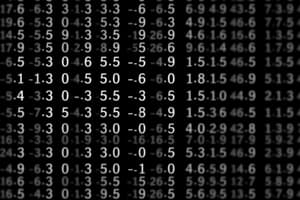Podcast
Questions and Answers
When is a matrix in echelon form? (Select all that apply)
When is a matrix in echelon form? (Select all that apply)
- All entries in a column below a leading entry are zeros (correct)
- All nonzero rows are above any rows of all zeros (correct)
- All entries in the leading row are non-zero
- Each leading entry of a row is in a column to the right of the leading entry of the row above it (correct)
What does RREF stand for?
What does RREF stand for?
Reduced Row Echelon Form
What is a pivot column?
What is a pivot column?
A pivot position is a location that corresponds to a leading 1 in the reduced echelon form.
Define basic variable and free variable.
Define basic variable and free variable.
What is Span{v1...vp}?
What is Span{v1...vp}?
What is the definition of AX?
What is the definition of AX?
What does it mean for vectors to be linearly independent?
What does it mean for vectors to be linearly independent?
What is linear dependence?
What is linear dependence?
What are the conditions for a transformation to be linear?
What are the conditions for a transformation to be linear?
When is a linear transformation T: R^n to R^m onto?
When is a linear transformation T: R^n to R^m onto?
What is a linear transformation one-to-one?
What is a linear transformation one-to-one?
State the row-column rule for computing AB.
State the row-column rule for computing AB.
What does it mean for a linear transformation T: R^n to R^n to be invertible?
What does it mean for a linear transformation T: R^n to R^n to be invertible?
What is an elementary matrix?
What is an elementary matrix?
What is the transpose of matrix A?
What is the transpose of matrix A?
What is the significance of Theorem 4?
What is the significance of Theorem 4?
When does the homogeneous equation Ax = 0 have a nontrivial solution?
When does the homogeneous equation Ax = 0 have a nontrivial solution?
What does it mean for T to be one-to-one and onto?
What does it mean for T to be one-to-one and onto?
State the Inverse Matrix Theorem.
State the Inverse Matrix Theorem.
If A is an invertible nXn matrix, what can be said about the solutions for each b in R^n?
If A is an invertible nXn matrix, what can be said about the solutions for each b in R^n?
Flashcards are hidden until you start studying
Study Notes
Echelon Form
- A matrix is in echelon form if all nonzero rows are positioned above rows of all zeros.
- Each leading entry in a row must be to the right of the leading entry in the row above.
- All entries below a leading entry must be zeros.
Reduced Row Echelon Form (RREF)
- Leading entries in each nonzero row are equal to 1.
- Each leading 1 is the only nonzero entry in its respective column.
Pivot Columns
- A column containing a leading 1 in the reduced echelon form, indicating a pivot position.
Basic and Free Variables
- Basic variables correspond to pivot columns in a matrix.
- Free variables are those that do not correspond to a pivot column.
Span
- Span{v1...vp} represents the set of all linear combinations of vectors v1 to vp in R^n, expressed as c1v1 + c2v2 + ... + cpvp.
Product of Matrices (AX)
- The product of matrix A and vector x is a linear combination of the columns of A, with corresponding entries of x serving as weights.
Linear Independence
- A set of vectors is linearly independent if the equation x1v1 + ... + xpvp = 0 has only the trivial solution.
- No vector in the set can be expressed as a linear combination of the others.
Linear Dependence
- A set of vectors is linearly dependent if there exists a non-trivial combination that equals zero.
- A zero vector in the set indicates linear dependence, as does having more variables than equations.
Linear Transformations
- A transformation T is linear if it satisfies T(U+V) = T(U) + T(V) and T(cU) = cT(U).
- A linear transformation from R^n to R^m is onto if every b in R^m can be produced from at least one x in R^n.
- A transformation is one-to-one if it maps each b in R^m to at most one x in R^n, ensuring no free variables and linear independence of columns.
Row-Column Rule for Matrix Multiplication
- If AB is defined, the entry in row i and column j is the sum of products of row i of A and column j of B.
Invertibility of a Linear Transformation
- A transformation T: R^n to R^n is invertible if there exists an inverse function S such that S(T(x)) = x and T(S(x)) = x.
Elementary Matrices
- Elementary matrices are obtained by performing a single elementary row operation on an identity matrix.
Transpose of a Matrix
- The transpose of an mxn matrix A, denoted A^T, is an nxm matrix, where rows of A become columns of A^T.
Homogeneous Equations
- The homogeneous equation Ax = 0 has a nontrivial solution if at least one free variable exists.
Linear Transformation Conditions
- A linear transformation T maps R^n onto R^m if the columns of its standard matrix A span R^m.
- T is one-to-one if the columns of A are linearly independent.
Inverse Matrix Theorem
- A matrix A is invertible if it is row equivalent to the identity matrix, has n pivot positions, and the equation Ax = 0 has only the trivial solution.
- Its columns form a linearly independent set and span R^n.
Inversion and Linear Transformations
- For an invertible n x n matrix A, there is a unique solution for each b in R^n, maintaining consistency across transformations.
Studying That Suits You
Use AI to generate personalized quizzes and flashcards to suit your learning preferences.




